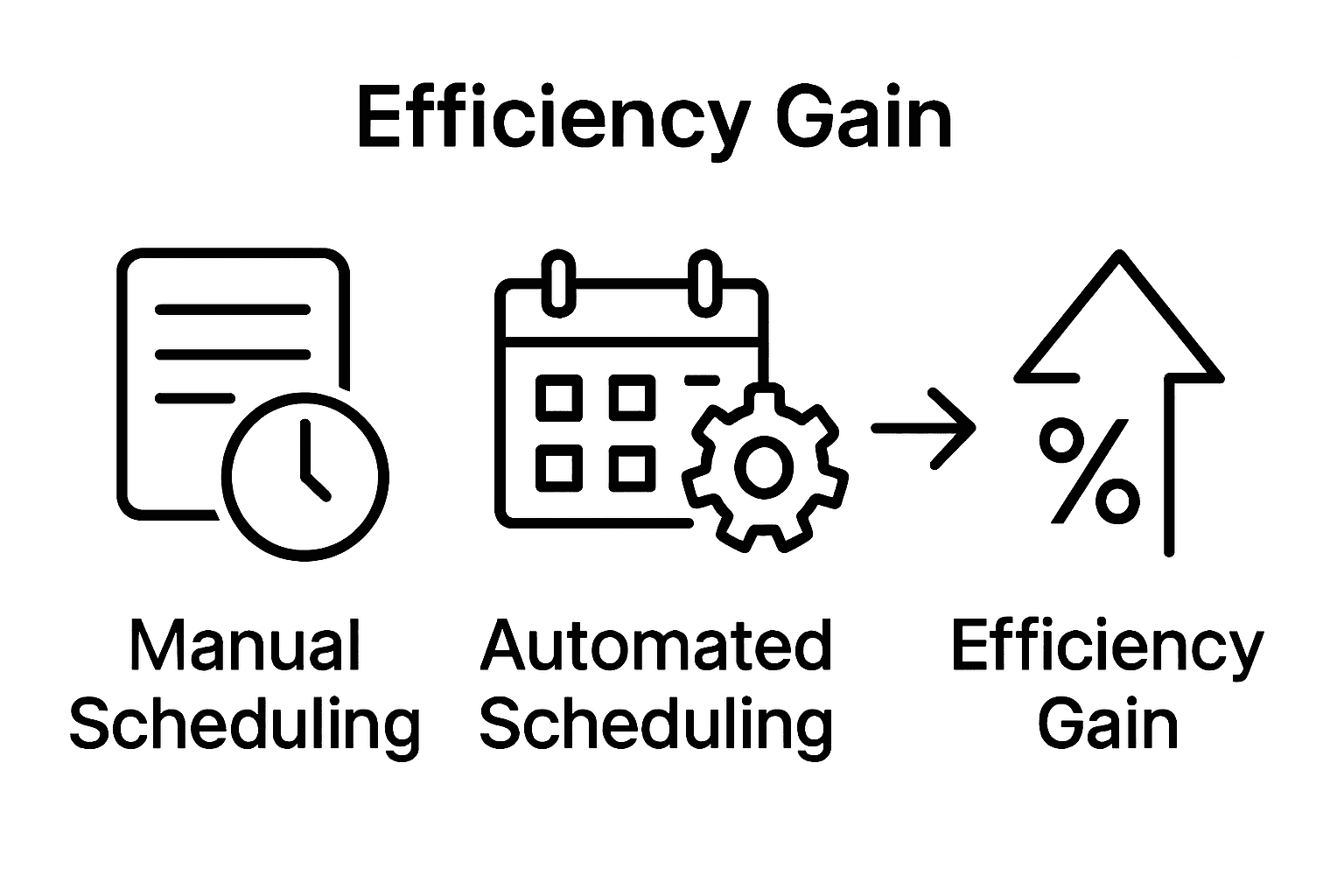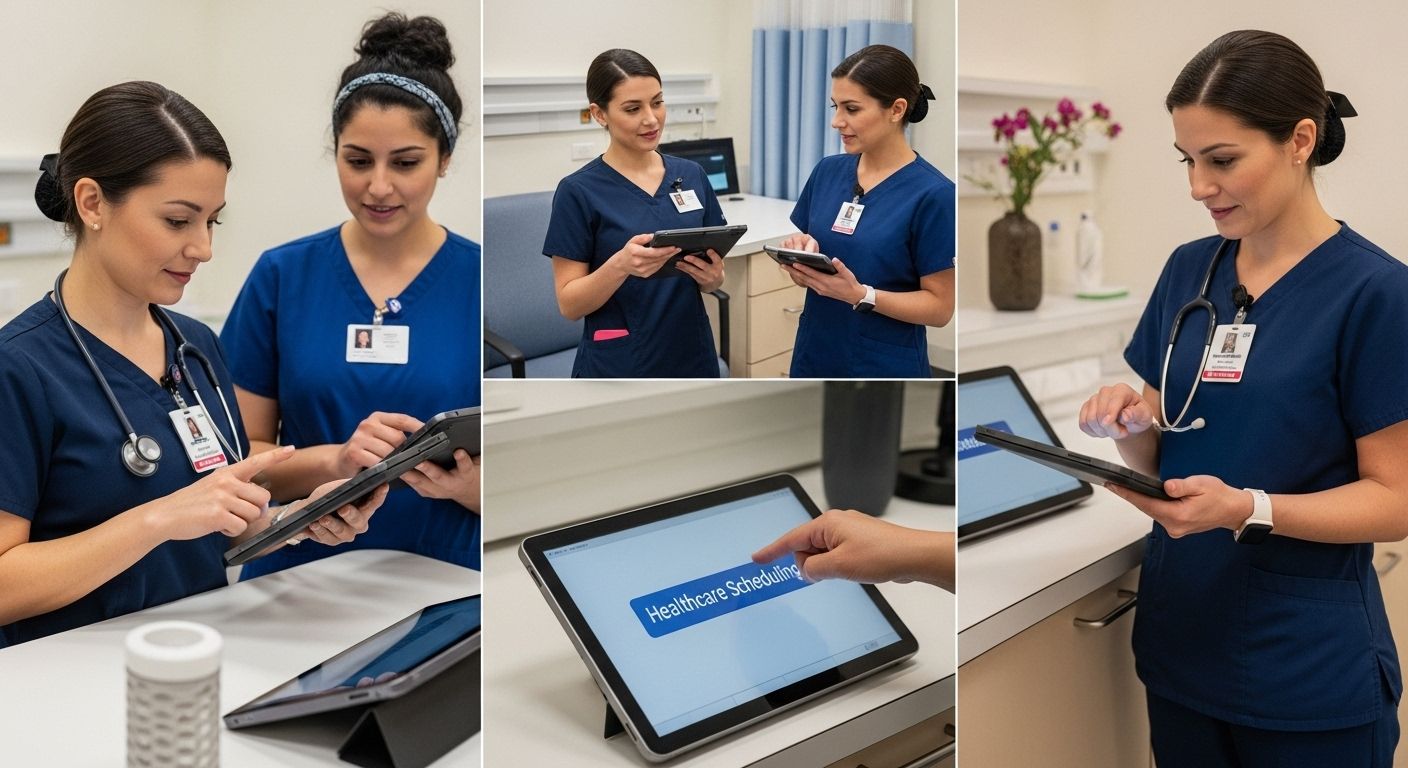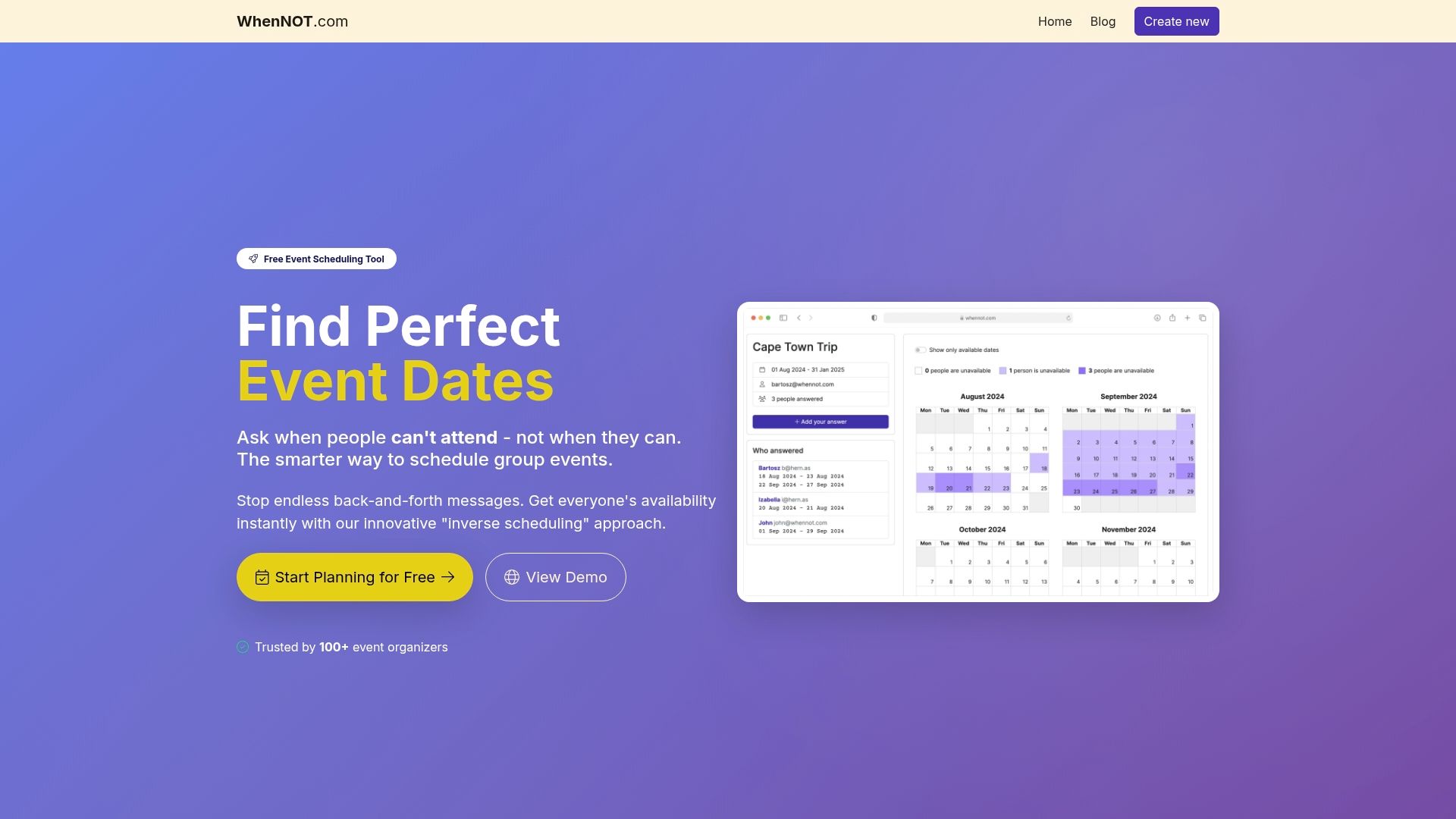Automated scheduling is changing how we manage meetings, appointments, and busy calendars. Most people still spend hours juggling schedules and sending reminder emails. But the real surprise is that professionals lose an average of 4.8 hours per week just trying to coordinate meetings. Imagine what could happen if that time went back into real work instead of endless scheduling headaches.
Table of Contents
- Defining Automated Scheduling: A Clear Explanation
- The Importance of Automated Scheduling in Event Planning
- How Automated Scheduling Works: Key Components
- Practical Applications of Automated Scheduling in Various Contexts
- Future Trends in Automated Scheduling: What to Expect
Quick Summary
| Takeaway | Explanation |
|---|---|
| Automated scheduling reduces human error. | By minimizing manual input, automated scheduling enhances accuracy and efficiency in time management. |
| Dynamic adaptability is key. | Systems can adjust schedules in real-time based on changing conditions, ensuring maximum participation and resource use. |
| Complex algorithms optimize scheduling. | Automated solutions analyze multiple variables simultaneously to find efficient scheduling arrangements quickly. |
| Data integration enhances effectiveness. | Robust systems combine data from various sources, enabling smarter and more nuanced scheduling decisions. |
| AI will transform future scheduling. | Emerging AI technologies will allow systems to anticipate needs and suggest optimal times based on personal patterns. |
Defining Automated Scheduling: A Clear Explanation
Automated scheduling represents a transformative approach to organizing time, tasks, and resources without manual intervention. At its core, this technology enables systems to intelligently assign and manage schedules with minimal human input, dramatically reducing administrative complexity and potential human error.
The Fundamental Concept of Automated Scheduling
In technical terms, automated scheduling is a computational process that systematically allocates resources, time slots, and tasks based on predefined rules, algorithms, and constraints. According to computational research), this approach optimizes resource utilization by automatically determining the most efficient sequence and timing of activities.

Key characteristics of automated scheduling include:
- Dynamic Adaptability: Capable of adjusting schedules in real time based on changing conditions
- Rule-Based Processing: Operates using predetermined logic and parameters
- Efficiency Optimization: Minimizes wasted time and maximizes resource allocation
How Automated Scheduling Works
The mechanism behind automated scheduling involves complex algorithmic decision making. Sophisticated software analyzes multiple variables simultaneously such as individual availability, task priorities, resource constraints, and temporal dependencies. These systems can process exponentially more scheduling scenarios than manual methods, identifying optimal arrangements faster and more accurately.
By leveraging artificial intelligence and machine learning techniques, modern automated scheduling solutions can learn from historical data, continuously improving their scheduling accuracy and effectiveness. This means the system becomes more intelligent with each scheduling cycle, progressively refining its decision making capabilities.
Real World Applications
Automated scheduling finds applications across numerous domains including business operations, healthcare management, transportation logistics, and personal productivity. Whether coordinating complex multi-team project timelines or managing individual appointment bookings, these systems provide unprecedented efficiency and precision in time management.
The Importance of Automated Scheduling in Event Planning
Event planning represents a complex coordination challenge that demands precision, flexibility, and efficiency. Automated scheduling emerges as a critical solution, transforming how group events are organized and managed across various contexts from professional conferences to family reunions.
Streamlining Complex Coordination Challenges
Traditional event planning involves extensive back-and-forth communication, multiple email threads, and significant time investment in finding mutually convenient schedules. According to meeting coordination research, professionals spend an average of 4.8 hours per week scheduling meetings, representing substantial administrative overhead.
Key challenges in manual event scheduling include:
- Participant Availability Tracking: Coordinating multiple individual schedules
- Time Zone Complexity: Managing participants across different geographic regions
- Rapid Communication Requirements: Ensuring swift decision making and confirmation
Reducing Planning Friction and Complexity
Automated scheduling tools eliminate traditional coordination barriers by providing intelligent, real time scheduling capabilities. These systems analyze participant constraints, preferences, and availability simultaneously, generating optimal scheduling solutions that minimize conflicts and maximize participation.
By implementing sophisticated algorithms, automated scheduling platforms can instantly evaluate hundreds of potential time slots, considering intricate variables like individual preferences, recurring commitments, and organizational constraints. This computational approach dramatically reduces the mental load associated with event planning.
Strategic Benefits for Event Organizers
Beyond basic scheduling, automated tools offer strategic advantages for event planners. They provide comprehensive visibility into participant availability, enable transparent communication, and create data driven insights that improve future planning processes. Whether organizing corporate retreats, academic conferences, or social gatherings, these technologies empower organizers to focus on content and experience rather than administrative logistics.
How Automated Scheduling Works: Key Components
Automated scheduling represents a sophisticated technological ecosystem where multiple interconnected components work seamlessly to transform complex scheduling challenges into efficient, intelligent solutions. Understanding these key components provides insight into the remarkable capabilities of modern scheduling technologies.
Below is a table summarizing the main components of automated scheduling systems, clarifying their core functions and roles in the scheduling process.
| Component | Description |
|---|---|
| Algorithmic Intelligence | Uses advanced algorithms to evaluate variables and identify optimal scheduling arrangements |
| Constraint Satisfaction | Analyzes and respects individual scheduling limitations and requirements |
| Data Management and Integration | Collects and synchronizes data from calendars, communication, and organizational systems |
| Optimization Techniques | Selects schedules that maximize efficiency and minimize conflicts |
| Predictive Analysis | Learns from historical data to anticipate needs and avoid future conflicts |
| Machine Learning Capabilities | Improves scheduling outcomes by adapting based on past performance and detected patterns |
| Real-Time Adaptability | Adjusts schedules dynamically as conditions and participant availability change |
Algorithmic Intelligence and Decision Making
According to computational research, automated scheduling systems rely on advanced algorithms that process multiple variables simultaneously. These algorithms function as the brain of the scheduling system, evaluating countless potential configurations to identify optimal scheduling arrangements.
Core algorithmic capabilities include:
- Constraint Satisfaction: Analyzing and respecting individual scheduling limitations
- Optimization Techniques: Selecting schedules that maximize efficiency and minimize conflicts
- Predictive Analysis: Learning from historical scheduling patterns
Data Management and Integration
Effective automated scheduling depends on robust data management infrastructure. These systems integrate information from diverse sources, creating a comprehensive view of available resources, participant constraints, and scheduling preferences. Advanced platforms can simultaneously process data from calendars, communication platforms, and organizational management systems.
The data integration process involves sophisticated techniques like real time synchronization, cross platform compatibility, and intelligent data interpretation. This allows scheduling systems to make nuanced decisions that account for complex human and organizational constraints.
Machine Learning and Adaptive Capabilities
Modern automated scheduling technologies leverage machine learning to continuously improve their performance. By analyzing past scheduling outcomes, these systems develop increasingly sophisticated understanding of scheduling dynamics. They can identify subtle patterns, predict potential conflicts, and recommend increasingly refined scheduling solutions over time.
This adaptive approach transforms scheduling from a static administrative task into a dynamic, intelligent process that learns and evolves with each interaction. The result is a scheduling system that becomes progressively more accurate, efficient, and aligned with user needs.
Practical Applications of Automated Scheduling in Various Contexts
Automated scheduling has revolutionized time management across multiple industries, offering transformative solutions that extend far beyond traditional administrative processes. By intelligently managing complex scheduling requirements, these technologies provide unprecedented efficiency and precision across diverse professional and personal domains.
This table organizes the practical applications of automated scheduling technology across different industries to help visualize how its benefits extend to varied domains.
| Industry | Primary Applications | Key Benefits |
|---|---|---|
| Healthcare | Patient appointments, staff rotations, resource allocation | Reduces wait times, avoids conflicts |
| Business | Meeting coordination, project timelines, team synchronization | Lowers admin overhead, enhances efficiency |
| Education | Class timetabling, faculty workload, student consultations | Streamlines operations, improves fairness |
| Event Planning | Group scheduling, participant availability, multi-time zone management | Maximizes attendance, minimizes friction |
| Personal Productivity | Appointment management, task scheduling | Automates reminders, boosts organization |
Healthcare and Medical Services
According to medical research, automated scheduling has become instrumental in healthcare management. Medical facilities utilize these systems to optimize patient appointments, manage specialist rotations, and coordinate intricate healthcare delivery processes. The technology enables hospitals and clinics to reduce patient wait times, minimize scheduling conflicts, and ensure optimal resource allocation.

Key healthcare scheduling applications include:
- Appointment Management: Streamlining patient consultations and follow up visits
- Staff Rotation Coordination: Managing complex medical professional schedules
- Resource Allocation: Optimizing medical equipment and room assignments
Business and Professional Environment
In corporate settings, automated scheduling transforms how teams collaborate and manage time sensitive projects. These systems integrate seamlessly with existing communication platforms, enabling organizations to coordinate meetings, track project timelines, and synchronize team activities across different geographic locations and time zones.
Advanced scheduling platforms can automatically adjust for individual preferences, recurring commitments, and organizational constraints. This intelligent approach reduces administrative overhead and allows professionals to focus on strategic work rather than logistical coordination.
Education and Academic Contexts
Educational institutions leverage automated scheduling to manage complex academic environments. From creating class timetables to coordinating student consultations and managing faculty workloads, these technologies provide comprehensive solutions that address the multifaceted scheduling challenges inherent in academic settings.
By utilizing sophisticated algorithms, educational scheduling systems can balance classroom availability, instructor preferences, student course requirements, and institutional constraints. The result is a more efficient, transparent, and responsive academic scheduling process that benefits students, faculty, and administrative staff alike.
Future Trends in Automated Scheduling: What to Expect
Automated scheduling technologies are rapidly evolving, driven by advances in artificial intelligence, machine learning, and complex computational capabilities. The future promises increasingly sophisticated systems that will transform how individuals and organizations manage time and resources.
Artificial Intelligence and Predictive Capabilities
According to technology forecasting research, artificial intelligence will play a transformative role in scheduling technologies. Future scheduling systems will move beyond reactive management to proactively anticipate scheduling needs, potential conflicts, and optimal time allocations.
Emerging AI driven scheduling capabilities include:
- Contextual Understanding: Interpreting nuanced personal and professional scheduling constraints
- Predictive Conflict Resolution: Anticipating potential scheduling challenges before they occur
- Personalized Recommendation Engines: Suggesting optimal time slots based on individual patterns
Hyper Personalization and Contextual Intelligence
Next generation scheduling platforms will develop unprecedented levels of contextual intelligence. These systems will integrate data from multiple sources personal calendars, communication platforms, productivity tools to create holistic scheduling experiences that adapt to individual working styles and preferences.
Advanced platforms will understand complex human behaviors, learning from past scheduling patterns to generate increasingly refined recommendations. This means scheduling will become more than a mechanical process of allocating time it will transform into an intelligent, adaptive experience that respects individual working rhythms and personal constraints.
Integration and Ecosystem Connectivity
Future automated scheduling technologies will emphasize seamless ecosystem integration. Rather than existing as standalone tools, these platforms will become deeply interconnected with various professional and personal technology environments. This integration will enable more fluid, intuitive scheduling experiences that transcend traditional technological boundaries.
Scheduling systems will likely become more modular, allowing users to customize and connect different scheduling components based on their specific needs. The result will be a more flexible, responsive approach to time management that can adapt to rapidly changing professional and personal landscapes.
Transform Group Scheduling Frustration Into Seamless Success
Struggling to coordinate group events often means running into the same obstacles described in our article about automated scheduling. Chasing down everyone’s availability and dealing with endless messages wastes time and erodes momentum. The article highlighted pain points like overlapping schedules, miscommunication, and the constant hassle of getting everyone on board. Traditional scheduling methods simply do not keep up with today’s need for speed and flexibility.

Experience the difference with WhenNOT. Our smart platform flips the old approach by letting participants quickly mark when they are not available—so you skip time-consuming back-and-forth. With strong privacy, no sign-up required, and a simple visual interface, you can instantly see the best dates for everyone. If you are ready to take control of your next event, visit https://whennot.com and start streamlining your group scheduling right now. Organize smarter and leave traditional scheduling stress behind.
Frequently Asked Questions
What is automated scheduling?
Automated scheduling is a technology that organizes time, tasks, and resources without manual intervention, allowing systems to intelligently manage schedules with minimal human input.
How does automated scheduling work?
Automated scheduling works through complex algorithms that analyze multiple variables, such as individual availability and task priorities, to identify optimal scheduling arrangements quickly and accurately.
What are the benefits of using automated scheduling for event planning?
Automated scheduling simplifies the coordination of events by minimizing back-and-forth communication, tracking participant availability seamlessly, and reducing the time spent on administrative tasks.
In what industries is automated scheduling commonly used?
Automated scheduling is widely used in various sectors, including healthcare for patient appointments, business for team collaboration, and education for managing class schedules and faculty workloads.
